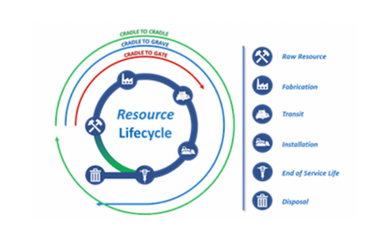Sustainability Series - Part 2
Understanding Product Emissions and Concrete Pipe
In this three-part series, the ACPA takes a look at the environmental factors surrounding the concrete pipe, its production, and its usage. Concrete, the most widely used building material in the world, is ripe with misperceptions about its environmental impact. Each of these blogs will help you better understand concrete pipe’s place as a sustainable infrastructure product.
What’s the impact of different building materials on relative global warming? According to recent data, reinforced concrete pipe (RCP) produces anywhere from 90% to 95% less CO2 emissions per unit weight than alternative product materials. To understand the total amount of emissions a product produces, it’s important to first examine the product’s entire life cycle. That starts with looking at product emissions.
CO2 Emissions
One of the primary sources of CO2 emissions for any storm sewer or culvert project can be traced to the pipe material production. Typically, these are called cradle-to-gate product emissions, which theoretically include all emissions to the point where the product is ready to be shipped from the facility in which it was produced. This type of data is generally available to interested parties and effectively summarizes the emissions associated with the extraction of raw materials, transport of raw materials to a processing/refining facility, processing/refining of raw materials, transport of raw materials to a manufacturing facility, and production of the end-product.

Emissions are expressed in kilograms of equivalent CO2 emissions per kilogram of material produced. When it comes to drainage pipes, this value can be used in conjunction with known pipe weights for the different materials and sizes to determine the emissions per foot of the finished product. For many products and materials, a good estimate of the cradle-to-gate emissions can be derived from the Inventory of Carbon and Energy (ICE) report published by the
Building Services Research & Information Association (BRSIA). The ICE report is a collection of best-available environmental data for common construction materials.
Concrete Pipe and CO2 Emissions
For concrete pipe, the ICE report suggests an emission factor somewhere between 0.180 and 0.242 kg CO2e/kg, depending on assumed concrete strengths and reinforcement levels; however, ASTM published a more detailed Environmental Product Declaration (EPD) specifically for underground precast drainage products. The value from this document – which specifically includes reinforced concrete pipe – was 221kg CO2e/metric tonne, or 0.221 kgC02e/kg. This value should be considered the most accurate cradle-to-gate emission value available for concrete pipe manufactured in North America.
Using this value, one can compare the relative global warming impact of different materials. A quick comparison in the following table, shows that RCP produces anywhere from 90% to 95% less CO2e emissions per unit weight than alternative product materials such as corrugated metal pipe (CMP), corrugated high density polyethylene pipe (HDPE) and corrugated polypropylene pipe (PP).
%20(600%20%C3%97%20200%20px)%20(618%20%C3%97%20226%20px).png?width=1000&name=Copy%20of%20Blog%20Thumbnail%20(Letter)%20(600%20%C3%97%20200%20px)%20(618%20%C3%97%20226%20px).png)
To learn more about concrete pipe and sustainability watch Resilience & Sustainability Webinar – American Concrete Pipe Association.


